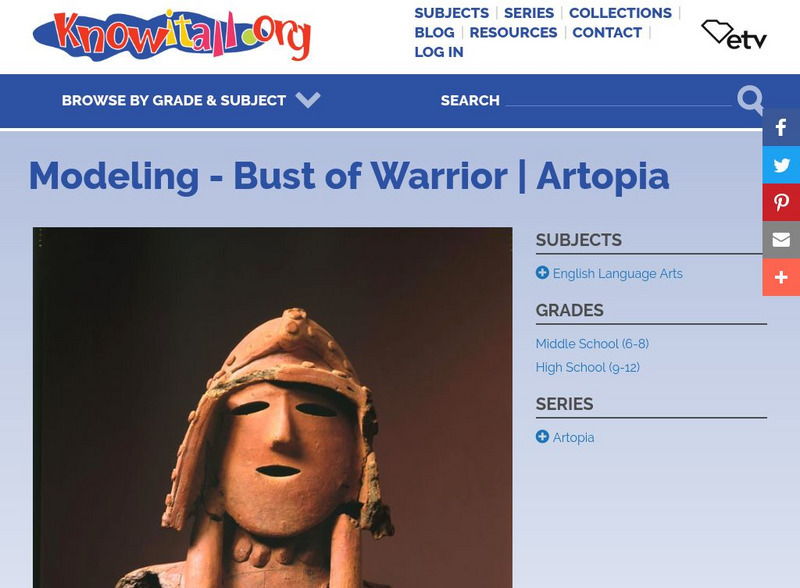Brooklyn Museum
Brooklyn Museum: Hiroshige's One Hundred Famous Views of Edo
Explanatory notes and images from an online exhibition of nineteenth-century woodcuts by one of Japan's most-revered artists, Utagawa Hiroshige. "Hiroshige's One Hundred Famous Views of Edo" represents over 100 prints of scenes of Tokyo...
Scholastic
Scholastic Instructor: Origami Math
Have you ever tried origami? This Japanese form of paper folding is the basis of this math lesson plan. Students will have an opportunity to integrate their creative side with their math skills.
South Carolina Educational Television
Etv: Artopia: Sculpture Critic: Bust of a Warrior
Resource about the Japanses sculpture Bust of a Warrior. Includes questions for reflection and a suggested art activity, an image of the sculpture and an audio version of the questions. Includes links for more information about the...
Other
The Clark Center for Japanese Art and Culture
This site contains examples of Japanese art. It is full of colorful images, and an explanation of the pieces.
Metropolitan Museum of Art
Metropolitan Museum of Art: The Kitano Tenjin Engi Emaki
Multimedia site introduces the legend, or "Engi," of the Kitano Shrine in Kyoto, Japan, as told on Japanese picture scrolls ("Emaki").
Huntington Library
Huntington Library: Garden Lesson Plans: Japanese Stone Lanterns [Pdf]
A study of the stone lanterns that can be found in Japanese gardens. Learners will learn about their history and symbolism, and create lanterns of their own out of clay. This is designed to be in conjunction with a visit to a Japanese...
Khan Academy
Khan Academy: Buddhism in Japan
Buddhism would revolutionize many aspects of Japanese life including music, dance, a new writing system, and above all, elaborate Buddhist art. View a picture of a Buddhist sculpture and read a brief history of Buddhism in Japan.
Khan Academy
Khan Academy: Seated Amitabha Buddha (Amida Nyorai)
This sculpture shows Amitabha, identified as the Buddha of the Western Paradise. Read a brief history of Amitabha and the techniques used to make this sculpture.
Khan Academy
Khan Academy: Female Shinto Spirit
This figure represents a Shinto goddess. Shinto images like this one were not meant to be seen but were kept hidden in movable cabinets in a special part of shrines, where they were privately worshiped. View a picture of this figure and...
Khan Academy
Khan Academy: A Guardian King
This fierce-looking king is a symbolic protector of the Buddha's sacred law and also a fighter of evil spirits. View a picture of this statue and read a short description.
Khan Academy
Khan Academy: The Steamship Powhatan
The picture shown in this essay is part of the Black Ship Scroll which depicts two of the nine American ships that arrived in Japan under Commodore Matthew Perry in 1854: U.S.S. Powhatan and U.S.S. Supply. Read the history of the U.S.S...
Khan Academy
Khan Academy: Utagawa Kunisada I, Visiting Komachi
"Visiting Komachi" by Utagawa Kunisada I is one of the images in the series "Modern Beauties as the Seven Komachi". Each scene in Kunisada's "Seven Komachi" series relates a story or anecdote associated with Komachi's life. View pictures...
Khan Academy
Khan Academy: Incense Container With Design of Plovers
This container is used to hold small chips of incense used in tea gatherings during the Muromachi period in Japan. View a picture and read about the imagery used when designing this container in this essay.
Khan Academy
Khan Academy: Helmet With Half Face Mask
View a picture of a samurai helmet and read about who wore the helmet, the purpose of the helmet, and how it was made.
Khan Academy
Khan Academy: The Shosoin Repository and Its Treasure
The Shosoin Repository survived both war and fire, leaving virtually all the ancient cultural treasures intact. The thousands of items preserved in the Shosoin repository include manuscripts, musical instruments, textiles, shoes,...
Khan Academy
Khan Academy: Tea Bowl With Standing Crane Design (Gohon Tachizuru)
View a picture of a Japanese tea bowl and read about how it was used in tea gatherings during the Muromachi period.
Khan Academy
Khan Academy: Short Sword (Wakizashi) and Long Sword (Katana)
Sword making is a highly refined and respected art in Japan, part of a ritualized process requiring decades of training. View two examples and read the background of the importance of swords to the Japanese people.
Khan Academy
Khan Academy: Fresh Water Jar
This vessel is a container to hold cold, freshwater made especially for use in the Japanese tea gathering during the Muromachi period. View a picture of this jar and read about the details in this essay.
Khan Academy
Khan Academy: Haniwa Warrior
We don't know much about haniwa or the Kofun Period because there was no writing system in Japan at the time. What we do know is that instead of being buried deep underground with the deceased, haniwa occupied and marked the open...
Khan Academy
Khan Academy: An Introduction to the Samurai
This article describes the rise and fall of the Shogunate in Japan. Included are pictures of Japanese art from these periods in Japanese history.
Khan Academy
Khan Academy: Japanese Art: The Formats of Two Dimensional Works
Japanese two-dimensional works of art can take several different formats. Read about handscrolls and hanging scrolls and view examples in this essay.
Khan Academy
Khan Academy: An Introduction to the Samurai
Learn about the origins of the Samurai, The First Warrior Government (The Kamakura Shogunate, 1185-1333, The Second Warrior Government: The Ashikaga Shogunate of the Muromachi Period (1338-1573), The Third Warrior Government: the...
Khan Academy
Khan Academy: Fresh Water Jar
This is a container to hold cold, fresh water made especially for use in the Japanese tea gathering. Its shape reminds us of a wooden bucket used to carry water from a well, but it is made out of porcelain, a glazed ceramic fired at a...
Khan Academy
Khan Academy: Military Camp Jacket
How was this jacket used? The military camp jacket (jinbaori) was worn over a suit of "modern equipment" or tosei gusoku armor. Though some jackets had sleeves, many were sleeveless vests like this one. The camp jacket offered protection...
























